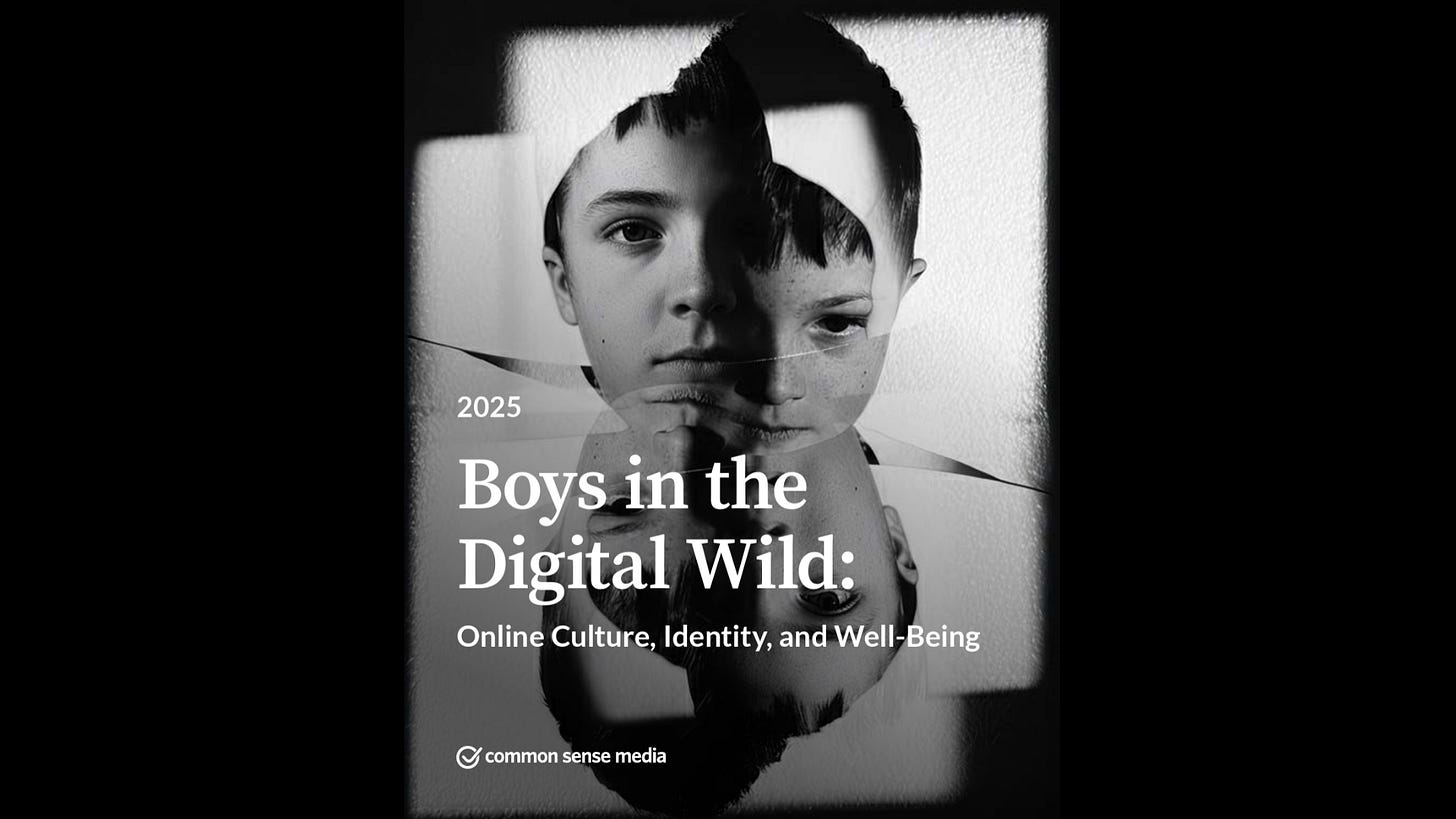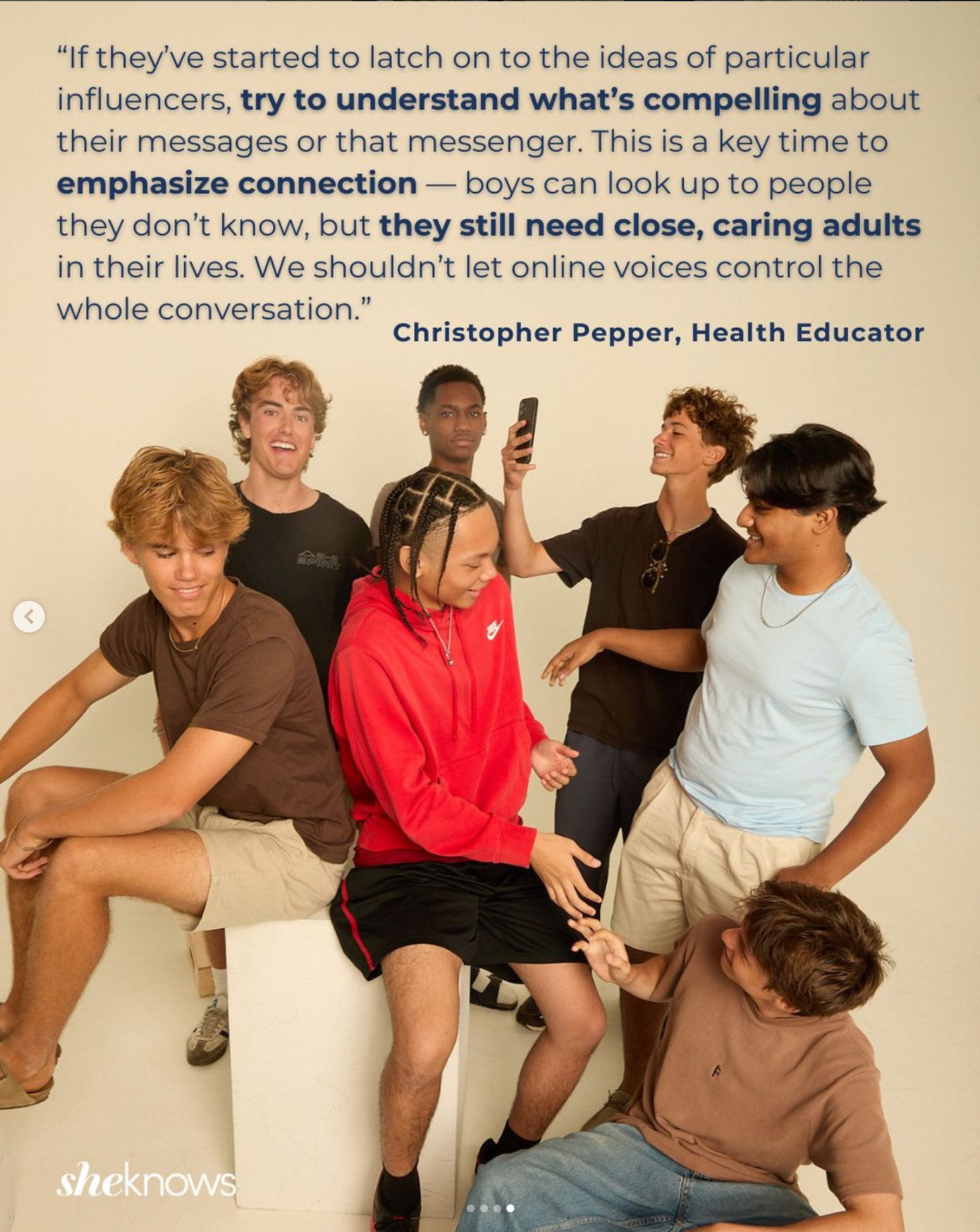What You Need To Know About The Algorithms Targeting Boys
Adolescent boys live and connect online - new research helps us understand what their experiences
Hi Readers!
In today’s newsletter, I’m sharing a crucial new report from Common Sense Media all about boys’ lives online. In addition to highlighting the data, I’m also sharing a conversation I had with Michael Robb, Ph.D., Common Sense Media’s Head of Research. We talked about the study’s findings and what parents and educators can do to stay connected to the boys in their lives. There is some incredible information here, and I hope you find it as compelling as I do.
Big Love,
— Christopher
Talk to Your Boys: Christopher Pepper In Conversation with Common Sense Media
From Common Sense Media: Today’s kids and teens are living in an always-connected world. For boys, this means regularly encountering masculinity-related online material that can include messages about making money, relationships, building muscle, and fighting. While these sorts of messages around masculinity have always been around, online experiences have increasingly influenced how boys see themselves and the world around them. While some of these experiences provide a sense of community for boys, others can be confusing and, at times, concerning.
Our new research examines the distinct pressures boys experience online around gaming, influencers, body image, and relationships—and how these may be shaping their development. Joining us for this episode of Conversations with Common Sense Media is Christopher Pepper, educator and co-author of Talk to Your Boys: 16 Conversations to Help Tweens and Teens Grow into Confident, Caring Young Men. Christopher shares his own insights into the research findings and what parents can do to support young men develop a healthy sense of identity. WATCH NOW
The Report: Boys In The Digital Wild: Online Culture, Identity, and Well-Being
This summer, Common Sense Media surveyed over 1,000 boys about their experiences online - how they spend their time, what they look at, and how it influences them. I served as an advisor on this report, helping shape the questions and the final report, and I think the results are powerful.
Here are the top line findings:
Nearly three-quarters of boys (73%) regularly encounter masculinity-related content, and nearly one in four (23%) experience high levels of exposure. Boys most commonly encounter messages about making money (44%), building muscle (39%), and fighting or weapons (35%).
Over two-thirds of adolescent boys (69%) regularly see masculinity content that promotes problematic gender stereotypes. This includes messages that girls only want to date certain types of guys (28%), that girls use their looks to get what they want (25%), that boys are treated unfairly compared to girls (12%), or that girls should focus on home and family (12%). Boys with high exposure to this material are significantly more likely to feel lonely, suppress their emotions, and avoid vulnerability. Nearly half of boys believe they must follow “unwritten rules,” like not crying or showing fear, to avoid being teased or picked on.
Ninety-one percent of boys encounter body image messages online, with three-quarters of boys exposed to online material about being muscular. Nearly one in four say social media makes them feel like they should change the way they look, and boys exposed to more masculinity-related posts were more than four times as likely than those with low exposure to say social media makes them feel they should change how they look.
Adolescent boys live and connect online, with 94 percent using social media or playing online games daily. For more than half of boys, digital platforms and gaming make them feel like they belong.
While most boys find a sense of belonging in gaming, 70 percent observe bullying or harassment and more than half hear racist, homophobic, or misogynistic language.
Algorithms, not user intent, are the primary driver of boys’ exposure to posts about masculinity. 68 percent of boys who see such material online say it started showing up in their feed without them searching for it.
Influencers have emerged as significant sources of guidance and emotional support for adolescent boys. Sixty percent of boys find influencers inspirational, and 56 percent report receiving practical advice from them.
A New Report Warns That Digital Culture Is Defining Boyhood — More Than Parents or Schools
The report got some significant media coverage. One of my favorite stories is this one from SheKnows, which features commentary from me,
, , Scott Galloway (), and a lot of teenagers from the SheKnows Teen Council.How The Today Show Covered This Study
NBC’s Kate Snow did a great job reporting on this research for TODAY, including an interview with Common Sense Media founder and CEO
.Recent Teen Health Today Highlights:
Should Schools Offer Hikes Instead Of Detention?
A new alternative shows promise. PLUS: California bans ultraprocessed foods in school lunches, and teachers try to protect immigrant students.
Our Book Came Out One Month Ago - Here’s What Happened Next
Nerves, thrills, and laughter on the way to the bestseller list
TikTok Videos About The Pill Prompt Alarm
Some doctors worry about social media's messages about birth control. PLUS: Why American kids are less likely to make it to adulthood than peers in other countries
Live Conversation with Priya Parker & the authors of Talk To Your Boys
A recording from Priya Parker’s live talk with Christopher Pepper and Joanna Schroeder
Why America’s Boys are Struggling
CBS Reports explores how boys and men are struggling to navigate this new era of masculinity — and how an online ecosystem is shaping their beliefs, identities and futures.
13-Year-Old: ‘Everything I Learned About Suicide, I Learned On Instagram.’
Is social media encouraging teens to take their own lives? PLUS: How the U.S. government is trying to access trans teens' private medical data.
If you enjoyed this post, please forward it to someone else who might like it, and click the ❤️ or 🔁 button on this post so more people can discover it on Substack. 🙏🏼






